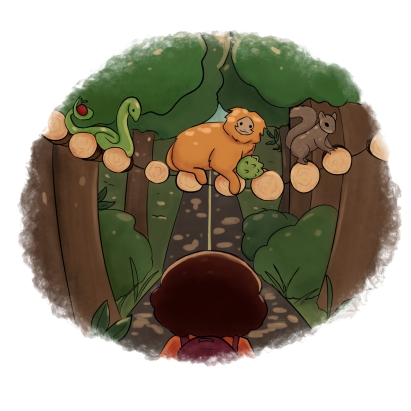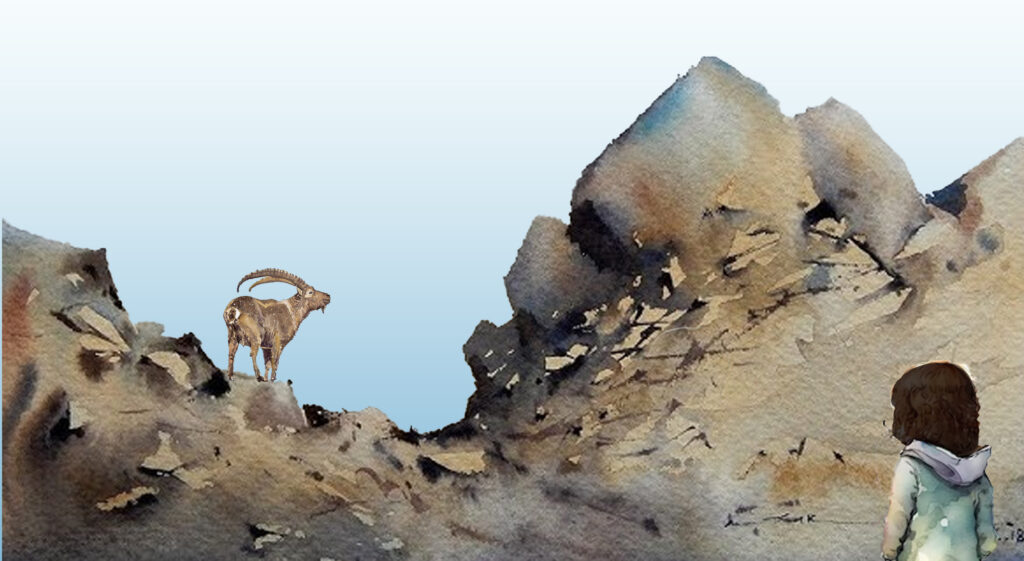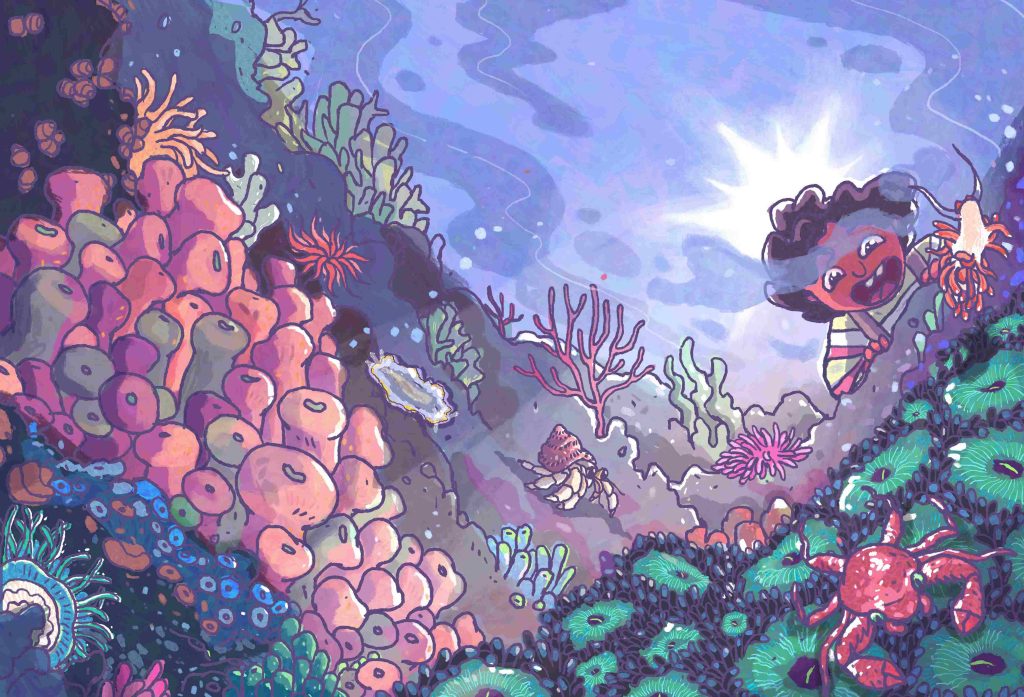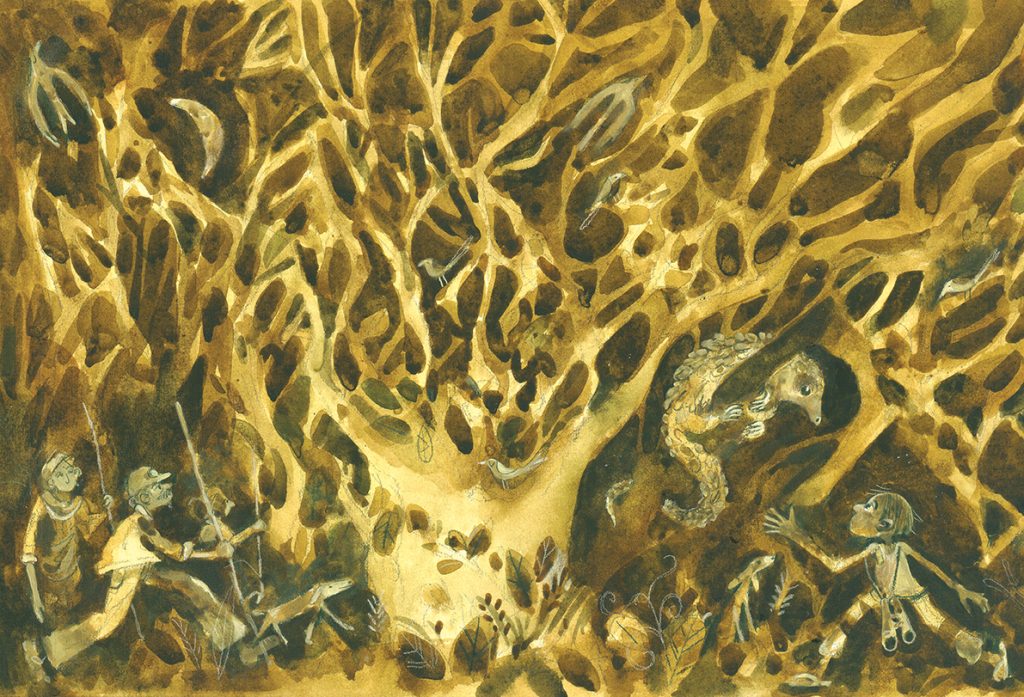The Mata Atlântica is known as the Brazilian Atlantic Forest, and growing up it had always been Elena’s happy place. Mata Atlântica is a place of beauty and nature, filled with creatures of all colours and plants unlike anywhere else. In her 11 years, Elena had come to know every fern and every moss and had smelled every air plant that clung to the trees and vines. Elena had climbed each Pau-Brasil redwood tree and had made friends with nearly every animal and bug that crawled, climbed or flew across the terrain.
This morning, as she did every morning, Elena was walking along the small dirt path which led from her house to school. It was the first day back from summer break, and this year Elena would be joining Room 9 in the schoolhouse.
Skipping through the trees, Elena soaked in the sounds and smells of the forest around her. The Mata Atlântica was magical in the mornings as the birds began to chirp and the early pollinators began spreading the sweet smell of flower pollen and nectar.
Lost in her thoughts, Elena was jolted back to reality when she came across a new feature of her forest. It was a road. A two-lane road for cars. Elena stopped and stared at the fresh-laid tar. It had not been there two months ago on the last day of school.
When she made it to her tiny schoolhouse, Elena made sure to ask about the road.
The teacher Miss Martins explained, “That road was built over the summer, so that people do not have to drive all the way around the large forest to get between cities anymore. Unfortunately, some of the trees had to be cut down to make room for the new road.”

With her question answered, the rest of the day passed quickly. Pretty soon, Elena was waving goodbye to her friends outside.
As she made her way home after school, Elena listened to the sounds of the forest. That’s when she heard a new sound. It was a high-pitched chirping, similar to that of a small bird’s call. Curious, Elena followed the sound down the road and away from the schoolhouse. She walked until her little legs were nearly tired. At last, she found the source.
It was perched on a branch far above Elena’s head. The critter was smaller than a cat, had a tail longer than its body and bright orange fur the colour of fire. Elena was a curious girl who was not afraid of the strange animal. She kept her distance and observed.
“Are you stuck?” she asked.
The colourful creature looked down at her from its branch. “Yes,” it said, “I can’t get across.”
The orange ball of fur scurried down the tree branches and closer to Elena. “I’m a golden lion tamarin; I live in the trees. The problem is I cannot get across whatever this is,” the critter gestured at the dark tar.
“That’s a road,” Elena said. “It was built so that humans could travel through the forest.”
The golden lion tamarin looked sad. “But now I can’t travel through the forest.” “Can I help?” Elena asked. “I don’t think so.”
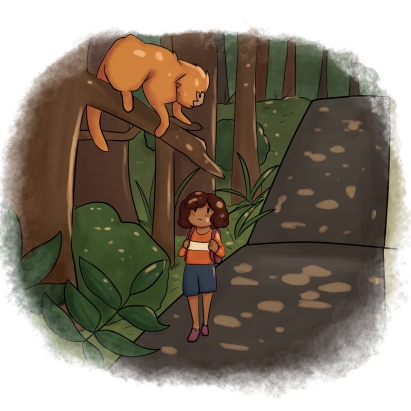
Disappointed she couldn’t help, Elena continued on her way home. The golden lion tamarin behind her skittered through the trees, continuing to look for a way across the road.
The next day, as Elena was once again heading home from school, she heard the call of the golden lion tamarin in the trees. This time, she found it closer to the schoolhouse. She decided to introduce herself. “I’m Elena.”
“I’m Mico,” the golden lion tamarin said.
“Where did you come from?” Elena asked.
Mico replied, “I live much deeper in the forest with my family. We live in a group.”
“Where are you going?”
“There are more groups of families like me that live all over the forest and in the other fragments. I’m trying to visit them, as well as my friend Preguiça, the maned sloth. I have not seen him in a while and wanted to visit, but now I can’t get across and have been looking for a new path.”
Elena was surprised. She had never seen a golden lion tamarin before, and now to know there were more of them was surprising. This was one of the many reasons why she loved the forest, she learned something about the environment and animals each time she went outside. But she did not understand; Elena could get across the road, why couldn’t Mico? “I’m arboreal,” Mico explained, “and my species likes to travel through the forest using the tree branches and vines. We don’t like to walk on the ground. It is slow and exposes us to predators like snakes and ocelot cats. Plus those big scary animals that people ride move much faster than I can. I’m afraid to cross.”
Mico retreated back into the forest to continue his search for a safe place to cross the road. Over the next few days, Elena continued to think about Mico’s plight, and soon she saw more creatures gathered with Mico who could not get across. Marmosets, capuchin monkeys, opossums and other species of lion tamarins all struggled to cross the road. Mico and Preguiça, still separated by the road, sat on tree branches across from each other to wave hello.
One day, Elena’s kind heart could not take it any longer. When the class was looking for their yearly conservation project, she saw her chance and raised her hand.
“Miss Martins,” Elena said, “I have noticed there are a lot of animals that cannot get across the new road. Perhaps we could help them.”
“Great idea!” Miss Martins said. “Does anyone know how we could do this?”
One classmate suggested carrying the animals across. Miss Martin said that wild animals like those in the forest should not be handled by humans. Another classmate suggested a crosswalk and crossing guard. Someone else suggested a miniature helicopter that could be remotely controlled from the schoolhouse. Miss Martins said that both ideas would be distracting from regular class time. The last idea came from Elena’s friend Lalo. Lalo suggested stringing a rope across the road, from one tree to another, that the animals could climb across.
“That’s a good start, Lalo,” Miss Martins said. Lalo smiled with pride. “How can we expand on that idea?” Miss Martins wondered.
Elena raised her hand, “What if we made bridges?” she asked. “Ones that could hang from the trees above the road?” The suggestion felt wild, but Elena imagined it so clearly, she knew it would work.
And so began Room 9’s yearly conservation project: building bridges across the new road. The students of Room 9 avoided using any more of the precious forest’s resources by collecting twigs from the forest floor and from their backyards. They also collected rope and string from their homes and neighbourhoods that could be recycled. Very quickly the kids had collected enough recycled materials to construct the first bridge. They worked together to design a strong bridge that looked natural so that all the different animal species would feel comfortable using it. The first of Elena’s forest friends to use the bridge was the primate who started it all—Mico the golden lion tamarin.
“Thank you, Elena,” Mico said. He was perched on a low branch, having crossed the bridge successfully. His friend, Preguiça the maned sloth, was at last sitting beside him. “Now Preguiça and I can visit each other again, all thanks to you and your classmates.”
Elena looked up at the bridge. Many animals were already flowing across in both directions. Her classmates were standing on either side of the road, studying which species were using the bridge. Their next project was going to be how to improve the future bridges based on what species were using them.
Elena smiled at Mico and Preguiça. “I am so happy to be able to help,” she replied. “I did not realise before how something like a road could affect so many species. Our class is going to make a bunch more bridges to go along the whole road. Then you do not have to travel too far to a bridge. We’re going to do it using recycled materials so we don’t take away any more of the resources that you and your friends rely on.”
Just then, Elena heard a sound behind her. More of Mico’s friends had arrived, along with his family group, who had travelled from deep within the forest. They were carrying a variety of fruits and flowers from native plants within the forest. They were thank you gifts for Elena and her fellow students.
“We can never thank you enough,” Mico said, “for reuniting and bridging our forest.”

MEET THE CHARACTERS
| Mico the golden lion tamarin | Mico is a golden lion tamarin (mico-leão-dourado in Portuguese). His species name is Leontopithecus rosalia. Other species of tamarin in Brazil include golden-headed lion tamarin black lion tamarin and black-faced lion tamarin. All are very small monkeys that are endemic to the Mata Atlântica (meaning they can only be found there). All four species of lion tamarin are critically endangered due to deforestation and habitat fragmentation. |
| Preguiça the maned sloth | Preguiça is a maned sloth (preguiça-de-coleira in Portuguese). His species name is Bradypus torquatus. Maned sloths are endemic to the Mata Atlântica and are the most threatened species of sloth in the world due to deforestation and habitat fragmentation. |
| Snakes of the Mata Atlântica | Many different snake species live in the Mata Atlântica, and some are known to feed on golden lion tamarins, including anacondas, rainbow boas and pit vipers. Snakes aren’t all bad though! They help disperse seeds and are part of nature’s pest control. |
| Ocelot cats | Ocelots, Leopardus pardalis, are a carnivorous species of cat that hunt at night. They are found throughout the southwestern United States, Mexico, Central and South America, and in various climates. |
| Marmosets | The common marmoset, Callithix jacchus, also called the white-tufted or white-tufted-ear marmoset, are small monkeys that live throughout Brazil. They have become invasive in some states like Rio de Janeiro and are often targeted in the illegal pet trade. |
| Capuchin Monkey | Many different species of capuchin monkeys can be found throughout Brazil and in the Mata Atlântica. Capuchin monkeys are primarily arboreal primates that are omnivores, snacking on fruits, leaves and insects. |
| Opossum | Opossums are members of the marsupial order, along with animals such as kangaroos and koalas. Several species of opossum can be found in the Mata Atlântica including Wildlife bridge crossing the Brazilian slender opossums, white-eared opossums and Brazilian gracile opossums. |
